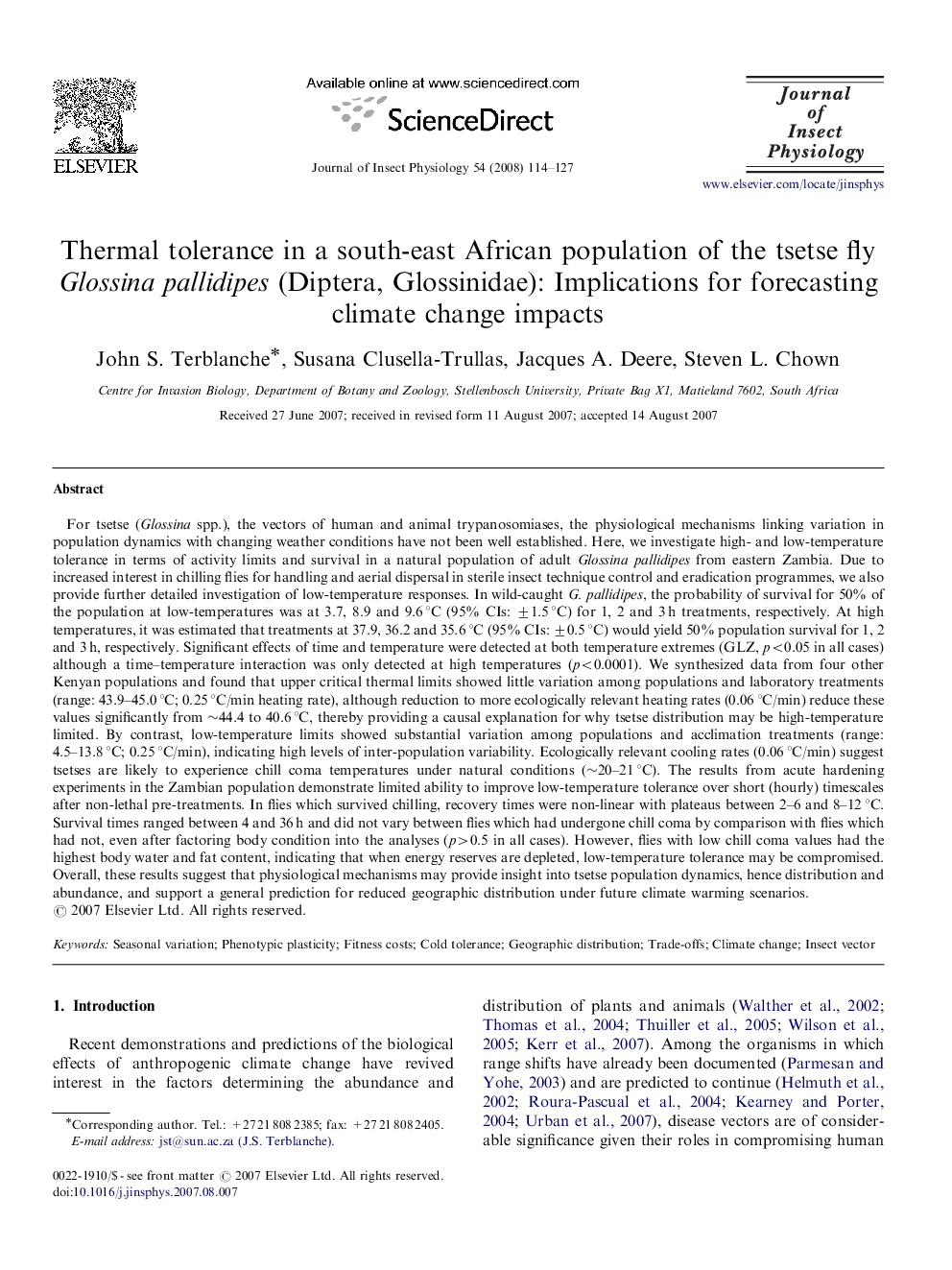| کد مقاله | کد نشریه | سال انتشار | مقاله انگلیسی | نسخه تمام متن |
|---|---|---|---|---|
| 2841422 | 1165397 | 2008 | 14 صفحه PDF | دانلود رایگان |

For tsetse (Glossina spp.), the vectors of human and animal trypanosomiases, the physiological mechanisms linking variation in population dynamics with changing weather conditions have not been well established. Here, we investigate high- and low-temperature tolerance in terms of activity limits and survival in a natural population of adult Glossina pallidipes from eastern Zambia. Due to increased interest in chilling flies for handling and aerial dispersal in sterile insect technique control and eradication programmes, we also provide further detailed investigation of low-temperature responses. In wild-caught G. pallidipes, the probability of survival for 50% of the population at low-temperatures was at 3.7, 8.9 and 9.6 °C (95% CIs: ±1.5 °C) for 1, 2 and 3 h treatments, respectively. At high temperatures, it was estimated that treatments at 37.9, 36.2 and 35.6 °C (95% CIs: ±0.5 °C) would yield 50% population survival for 1, 2 and 3 h, respectively. Significant effects of time and temperature were detected at both temperature extremes (GLZ, p<0.05 in all cases) although a time–temperature interaction was only detected at high temperatures (p<0.0001). We synthesized data from four other Kenyan populations and found that upper critical thermal limits showed little variation among populations and laboratory treatments (range: 43.9–45.0 °C; 0.25 °C/min heating rate), although reduction to more ecologically relevant heating rates (0.06 °C/min) reduce these values significantly from ∼44.4 to 40.6 °C, thereby providing a causal explanation for why tsetse distribution may be high-temperature limited. By contrast, low-temperature limits showed substantial variation among populations and acclimation treatments (range: 4.5–13.8 °C; 0.25 °C/min), indicating high levels of inter-population variability. Ecologically relevant cooling rates (0.06 °C/min) suggest tsetses are likely to experience chill coma temperatures under natural conditions (∼20–21 °C). The results from acute hardening experiments in the Zambian population demonstrate limited ability to improve low-temperature tolerance over short (hourly) timescales after non-lethal pre-treatments. In flies which survived chilling, recovery times were non-linear with plateaus between 2–6 and 8–12 °C. Survival times ranged between 4 and 36 h and did not vary between flies which had undergone chill coma by comparison with flies which had not, even after factoring body condition into the analyses (p>0.5 in all cases). However, flies with low chill coma values had the highest body water and fat content, indicating that when energy reserves are depleted, low-temperature tolerance may be compromised. Overall, these results suggest that physiological mechanisms may provide insight into tsetse population dynamics, hence distribution and abundance, and support a general prediction for reduced geographic distribution under future climate warming scenarios.
Journal: Journal of Insect Physiology - Volume 54, Issue 1, January 2008, Pages 114–127